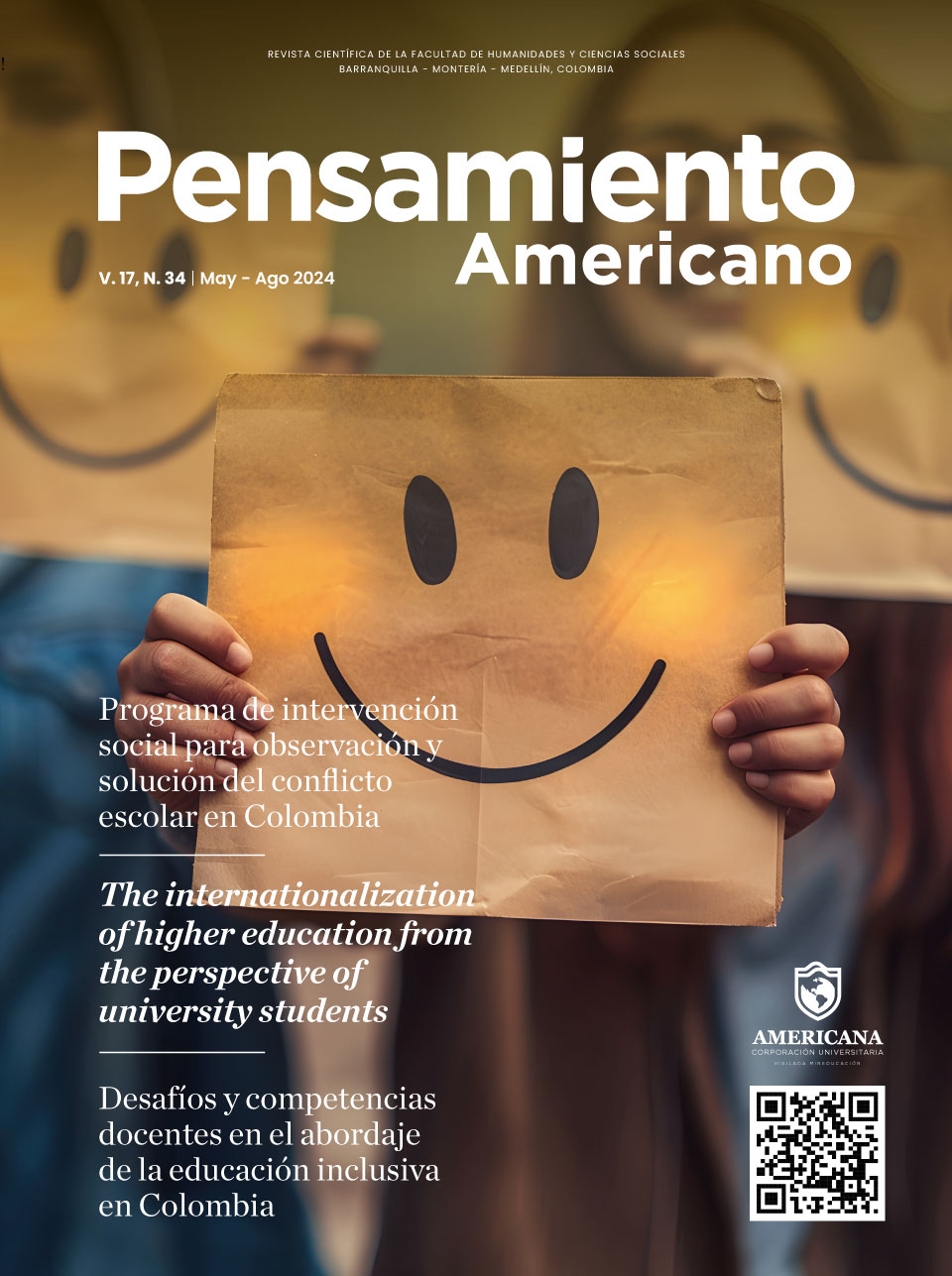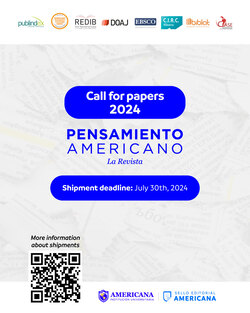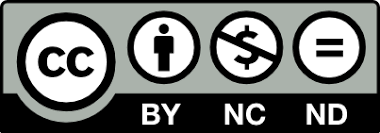Higher Inequality in Health Expenditures during Covid-19 Pandemic in Mexico
DOI:
https://doi.org/10.21803/penamer.17.34.768Keywords:
Health Expenditures, Economic Development, Welfare, Mexican EconomyAbstract
Introduction: The purpose of this research is to delve deeper into how the problem of inequality in access to healthcare during the COVID-19 pandemic worsened in Mexico. To address this important issue, the behavior of health expenditures of Mexican households was broken down through a descriptive statistical analysis using data from the National Survey of Household Income and Expenditure (ENIGH) for 2018, 2020, and 2022. The methodology includes the construction of income quintiles, types of expenditure, and the indicator of lack of access to health services. Additionally, a regional analysis was conducted. Our results show an overall increase in health expenditures of more than 30% between 2018 and 2022, with this phenomenon being more evident in households in the highest income quintile. Additionally, a significant deterioration in household well-being is observed, with greater vulnerability in households without access to health services, which have higher expenses compared to those with access to a health program. In regional terms, the southern part of the country showed higher health expenditures in proportion to their income, with a predominant focus on outpatient issues. These findings help identify the main problems of access and participation of households in absorbing health expenditures, suggesting the implementation of differentiated policy measures by the government aimed at improving access to health services and reducing potential catastrophic health-related expenses for households.
Downloads
References
Alcántara Balderas, M. A. (Ed.). (2012). La calidad de la atención a la salud en México a través de sus instituciones: 12 años de experiencia. Ciudad de México: Secretaría de Salud. Obtenido de http://www.calidad.salud.gob.mx/site/editorial/docs/calidad_atencion_salud_enMexico_12experiencia.pdf
Antúnez, M. (6 de Mayo de 2023). sinembargo.mx. Obtenido de El adiós del INSABI: Desaparición del Instituto de Salud deja en incertidumbre a pacientes y trabajadores: https://www.sinembargo.mx/06-05-2023/4357295
Castañeda-Silerio, J. A. (2023). El traspaso de la volatilidad del tipo de cambio a los precios del consumidor en México (2003-2021). Ciudad Juárez, Chihuahua, México: Universidad Autónoma de Ciudad Juárez (Asesores: Juan Medina y Cely Ronquillo).
CEEY. (2019). Centro de Estudios Espinosa Yglesias. Obtenido de Movilidad Social en México: Las Cinco Regiones: https://ceey.org.mx/movilidad-social-en-mexico-las-cinco-regiones/
CIEP. (10 de Octubre de 2022). Gasto en Salud y Objetivos de Desarrollo Sostenible. Ciudad de México. Obtenido de https://ciep.mx/M4vO
CIEP. (2024). Análisis del Presupuesto en Salud Rumbo a 2030. Ciudad de México: Centro de Investigación Económica y Presupuestaria (CIEP).
CONEVAL. (2019). Medición de la Pobreza. Anexo Estadístico de Pobreza en México, Anexo Estadístico 2018. México, D.F. Obtenido de Anexo estadístico.: https://www.coneval.org.mx/Medicion/MP/Paginas/AE_pobreza_2018.aspx
CONEVAL. (2019). Metodología para la medición multidimensional de la pobreza en México (Tercera ed.). Ciudad de México: Consejo Nacional de Evaluación de la Política de Desarrollo Social. Obtenido de https://www.coneval.org.mx/InformesPublicaciones/InformesPublicaciones/Documents/Metodologia-medicion-multidimensional-3er-edicion.pdf
CONEVAL. (2023). Estudio sobre el Derecho a la Salud 2023. Ciudad de México: Consejo Nacional de Evaluación de la Política de Desarrollo Social. Obtenido de https://www.coneval.org.mx/EvaluacionDS/PP/CEIPP/IEPSM/Documents/E_Derecho_Salud_2023.pdf
Delajara, M., & Graña, D. (2017). Intergenerational Social Mobility in Mexico and Its Regions: Results from Rank-rank Regressions. Documento de Trabajo CEEY. Obtenido de https://ceey.org.mx/wp-content/uploads/2018/06/06-Delajara-Gra%C3%B1a-2017.pdf
Díaz-González, E., & Ramírez-García, J. (2017). Catastrophic health expenditures, government transfers and remittances in Mexico. Papeles de Población, 23(91), 65-91. Obtenido de https://rppoblacion.uaemex.mx/article/view/9313
Frenk, J., Gómez-Dantés, O., & Knaul, F. (2009). The democratization of health in Mexico: Financial Innovations for Universal Coverage. Bulletin of the World Health Organization, 87, 542-48. Obtenido de https://www.ncbi.nlm.nih.gov/pmc/articles/PMC2704036/
Gómez-Dantés, O., & Frenk, J. (2019). Financing common goods: the Mexican system for social protection in health agenda. Health Systems & Reform, 5(4), 382-386. doi:https://doi.org/10.1080/23288604.2019.1648736
Gómez-Dantés, O., Sesma, S., Becerril, V. M., M. Knaul, F., Arreola, H., & Frenk, J. (Enero de 2011). Sistema de Salud en México. Salud Pública, 53(2), S220-S232. doi:https://www.scielo.org.mx/pdf/spm/v53s2/17.pdf
Gutiérrez, J., Heredia-Pi, I., Hernández-Serrato, M., Pelcastre-Villafuerte, E., Torres-Pereda, P., & Reyes-Morales, H. (noviembre-diciembre de 2019). Desigualdades en el acceso a servicios, base de las políticas para la reducción de la brecha en salud. Salud Pública de México, 61(6), 726-733. doi:http://dx.doi.org/10.21149/10561
Guzmán Flores, J. (2018). Seguro popular: evidencia de los avances en asignación de recursos públicos, acceso y cobertura de servicios de salud y protección financiera. Expresión Económica. Revista de análisis(40), 25-48. Obtenido de http://expresioneconomica.cucea.udg.mx/index.php/eera/article/view/938
Hendricks, L., & Schoellman, T. (2018). Human capital and development accounting: New evidence from wage gains at migration. The Quarterly Journal of Economics, 133(2), 665-700. doi:https://doi.org/10.1093/qje/qjx047
Hernandez-Torres, J., Avila-Burgos, L., Valencia-Mendoza, A., & Poblano-Verastegui, O. (2008). Evaluación Inicial del Seguro Popular sobre el Gasto Catastrófico en Salud en México. Revista de Salud Pública, 10(1), 18-32. Obtenido de https://www.redalyc.org/pdf/422/42210103.pdf
INEGI. (28 de noviembre de 2018). Subsistema de Información Demográfica y Social. Obtenido de Encuesta Nacional de Ingresos y Gastos de los Hogares (ENIGH), 2018 Nueva serie: https://www.inegi.org.mx/programas/enigh/nc/2018/
INEGI. (28 de NOVIEMBRE de 2020). Subsistema de Información Demográfica y Social. Obtenido de Encuesta Nacional de Ingresos y Gastos de los Hogares (ENIGH). 2020 Nueva serie: https://www.inegi.org.mx/programas/enigh/nc/2020/
INEGI. (28 de noviembre de 2022). Subsistema de Información Demográfica y Social. Obtenido de Encuesta Nacional de Ingresos y Gastos de los Hogares (ENIGH), 2022 Nueva serie: https://www.inegi.org.mx/programas/enigh/nc/2022/
INEGI. (2024). Encuesta Nacional de Ingresos y Gastos de los Hogares ENIGH 2024: Consulta pública para la actualización de variables sociodemográficas y clasificadores de la ENIGH 2024. Aguascalientes, Ags., México. Obtenido de https://www.inegi.org.mx/contenidos/app/consultapublica/doc/descarga/ENIGH2024/proyecto/cp_enigh24_doc_tec.pdf
Knaul, F. M., Arreola-Ornelas, H., Méndez-Carniado, O., Bryson-Cahn, C., Barofsky, J., Maguire, R., . . . Sesma, S. (s.f.). Evidence is good for your health system: policy reform to remedy catastrophic and impoverishing health spending in Mexico. The Lancet, 368(9549), 1828-1841. doi:https://doi.org/10.1016/S0140-6736(06)69565-2
Laurell, A. C. (2013). Impacto del Seguro Popular en el sistema de salud mexicano. Buenos Aires, Argentina: CLACSO. Obtenido de https://biblioteca.clacso.edu.ar/clacso/clacso-crop/20130807020931/ImpactodelSeguroPopular.pdf
Martínez, J., & Murayama, C. (2016). El sistema de atención a la salud en México. En C. Murayama, & S. M. Ruesga, Hacia un Sistema Nacional Público de Salud en México. Ciudad de México: UNAM. Obtenido de http://www.pued.unam.mx/publicaciones/28/Un_sistema.pdf
Nussbaum, M. C. (2011). Crear Capacidades: Propuestas para el Desarrollo Humano. Barcelona: Paidós.
Ogundari, K., & Abdulai, A. (2014). Determinants of Household's Education and Healthcare Spending in Nigeria: Evidence from Survey Data. African Development Review, 26(1), 1-14. doi:https://doi.org/10.1111/1467-8268.12060
Ogundari, K., & Awokuse, T. (2018). Human capital contribution to economic growth in Sub-Saharan Africa: does health status matter more than education? Economic Analysis and Policy, 58, 131-140. doi:https://doi.org/10.1016/j.eap.2018.02.001
Olaiz, G., Lezana, M. A., Fernández, S. B., Wong, R., & Sepúlveda, J. (enero-febrero de 1995). La medicina privada en Mexico: resultados del censo nacional de unidades hospitalarias privadas. Salud Pública México, 37(1), 12-18.
Parramore, L. (30 de November de 2021). Warning: COVID-Fueled Mental Health Crisis Will Be a Costly Second Pandemic. Obtenido de Institute for New Economic Thinking: https://www.ineteconomics.org/perspectives/blog/warning-covid-fueled-mental-health-crisis-will-be-a-costly-second-pandemic
Saldívar, B. (1 de Agosto de 2023). Del gasto en salud, 49 de cada 100 pesos proviene del sector privado. El Economista. Obtenido de https://www.eleconomista.com.mx/economia/Del-gasto-en-salud-49-de-cada-100-pesos-proviene-del-sector-privado-20230801-0092.html
Shultz, T. P. (1995). Investment in women's human capital. Chicago, IL, USA: University of Chicago Press.
Tamez González, S., & Eibenschutz, C. (2008). El seguro popular de salud en México: pieza clave de la inequidad en salud. Revista de salud pública, 10(1), 133-145. Obtenido de https://www.redalyc.org/pdf/422/42217847012.pdf
United Nations. (2021). United Nations Comprehensive Response to COVID-19. Washington, DC, USA: United Nations. Obtenido de https://unsdg.un.org/sites/default/files/2021-12/un-comprehensive-response-covid-19-2021.pdf
World Bank Group. (2022). Finance for an Equitable Recovery. Washington, DC, USA: International Bank for Reconstruction and Development / The World Bank. Obtenido de https://www.worldbank.org/en/publication/wdr2022#downloads
World Health Organization. (7 de April de 2024). WHO COVID-19 Dashboard. Obtenido de Number of COVID-19 deaths reported to WHO (cumulative total): https://data.who.int/dashboards/covid19/deaths
Downloads
Published
Versions
- 2024-09-09 (2)
- 2024-07-09 (1)
Issue
Section
License
Copyright (c) 2024 Pensamiento Americano

This work is licensed under a Creative Commons Attribution-NonCommercial-NoDerivatives 4.0 International License.
The author or authors of an article accepted for publication in the Journal Pensamiento Americano will transfer all of the patrimonial rights to the American University Corporation free of charge, within which are included: the right to edit, publish, reproduce and distribute both print media as digital, in addition to include in article in international indexes and / or databases, likewise, the Editorial Seal is authorized to use the images, tables and / or any graphic material presented in the article for the design of covers or posters from the same magazine. By assuming the patrimonial rights of the article, it may not be partially or totally reproduced in any printed or digital media without its express permission.
AUTHORITY ASPECTS
For the Pensamiento Americano Journal, all the authors of an article have made substantial contributions to the research and the manuscript, and they share the responsibility when the article presents errors, fraud in some way or violations of copyright.
After submitting an article, the journal does not accept the addition, deletion or change in the order of the authors, in addition we reserve the right to release the article when it has been submitted to the journal and under no circumstances will American Thought accept the article. withdrawal of an article during any phase of the editorial process






